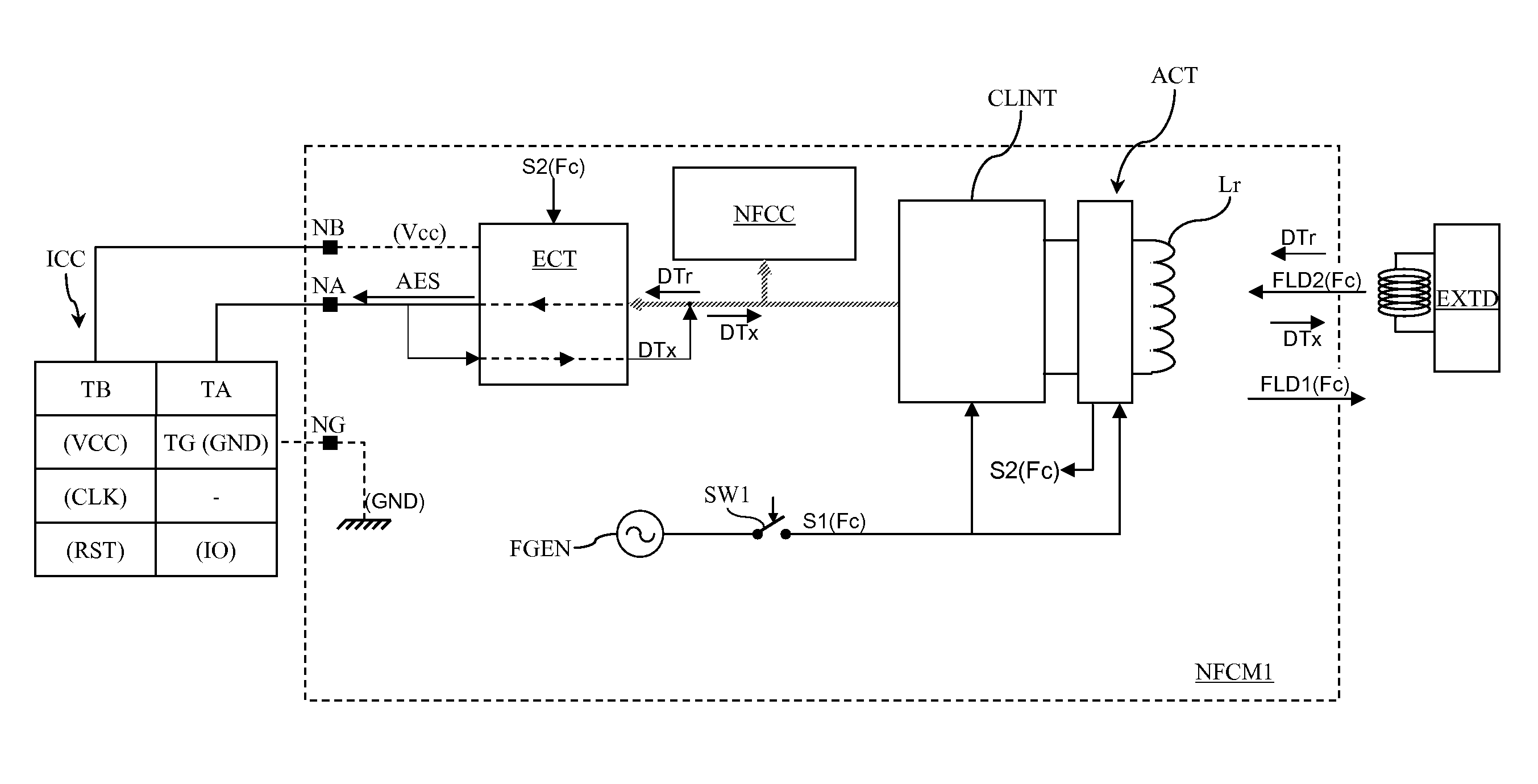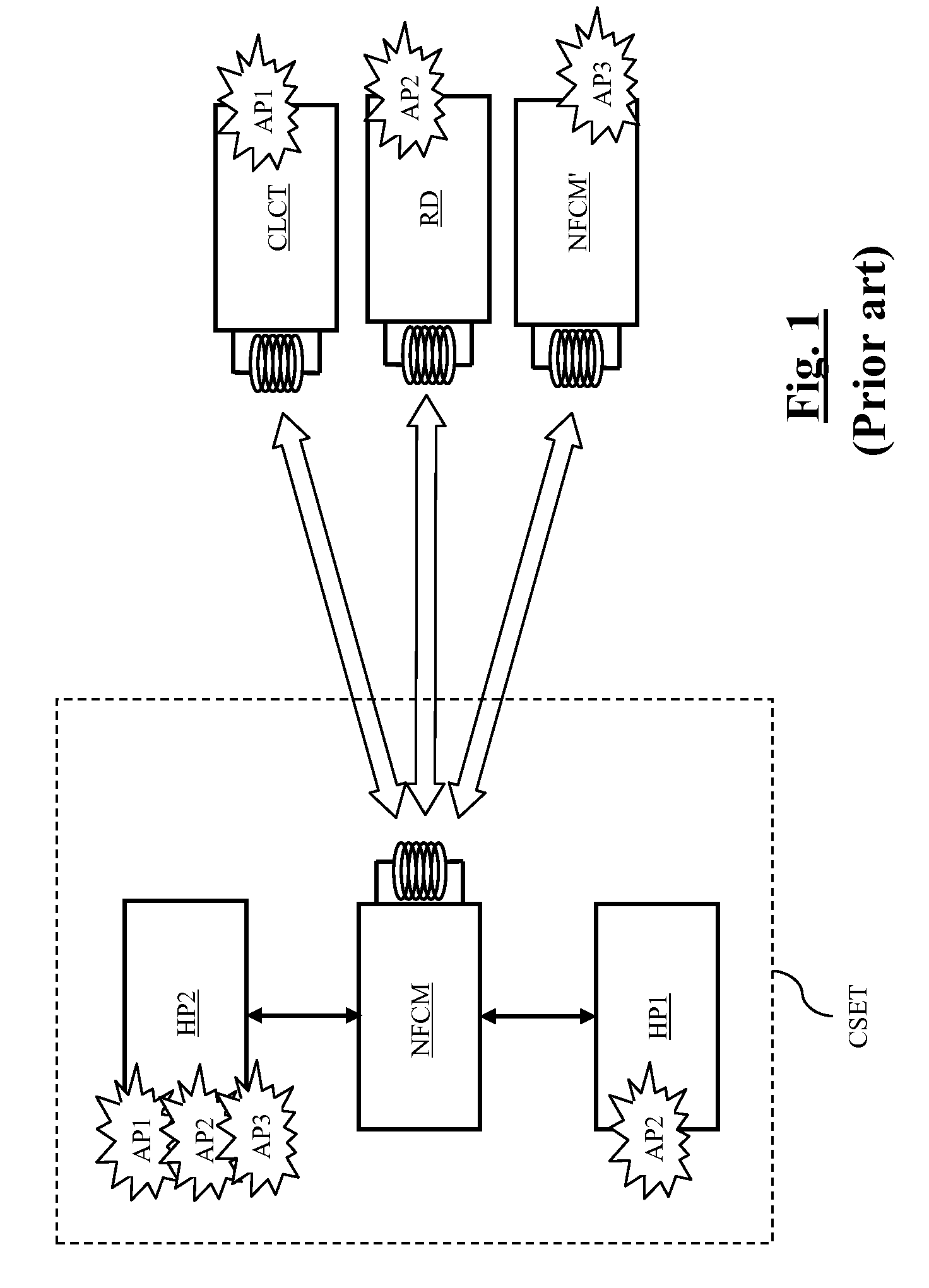Method for connecting a contactless integrated circuit to a NFC component
a contactless integrated circuit and component technology, applied in the field of nfc technology, can solve the problems of slow and low adaptability to high-rate data received by the component nfcm, high electrical consumption, and low efficiency of the integrated circuit, so as to rationalize the production of integrated circuits
- Summary
- Abstract
- Description
- Claims
- Application Information
AI Technical Summary
Benefits of technology
Problems solved by technology
Method used
Image
Examples
embodiment 1
, FIG. 13
[0156]In FIG. 13, the NFC component, designated “NFCM2”, is provided to receive another host processor HP2. It allows a communication to be established between, on the one hand the external device EXTD and on the other hand, the host integrated circuit ICC or the host processor HP2.
[0157]Performing the application concerned, for example an application of AP2 type, can for example be entrusted to the integrated circuit ICC if it is secure and if the application is not free or requires access conditions to secure (subscription for example). Performing the application can also be entrusted to the processor HP2 if it is not secure and if the application is free and without secure access condition. The processor HP2 can also be used to manage applications of AP1 or AP3 type (FIG. 2).
[0158]To that end, the outgoing data DTx carrier signal SDTx as applied to the circuit RFMOD can be supplied by the processor HP2, for example via the controller NFCC, or by the integrated circuit IC...
embodiment 2
, FIG. 14
[0160]In FIG. 14 the NFC component, designated “NFCM3”, differs from the component NFCM1 in that the NFC controller is interposed in the incoming and outgoing data flow. The incoming data carrier signal supplied by the demodulation circuit RFDEM to the controller NFCC is designated SDTr1 whereas the incoming data carrier signal supplied by the controller NFCC to the interface circuit ECT is designated SDTr2. Likewise, the outgoing data carrier signal supplied by the interface circuit ECT to the controller NFCC is designated SDTx1 and the outgoing data carrier signal supplied by the controller NFCC to the modulation circuit RFMOD is designated SDTx2.
[0161]The signal SDTr1 can be processed or not by the controller NFCC. If the controller NFCC sends the signal SDTr1 back to the interface circuit ECT as it is (SDTr2=SDTr1), the operating mode obtained is therefore identical to that of FIG. 7 (component NFCM3 transparent to the host integrated circuit). The controller NFCC can a...
embodiment 3
, FIGS. 15 and 16
[0164]The embodiment shown in FIG. 15 of the NFC component according to the invention, designated “NFCM4”, forms an entity of computational type in which data circulate on a data bus DTB associated to an address bus ADB, the data and address buses being controlled by the controller NFCC. In this embodiment, the interface circuit ECT according to the invention is a peripheral element of the controller NFCC.
[0165]The Component NFCM4 More Particularly Comprises:
[0166]the controller NFCC and the interface circuit CLINT already described;
[0167]a memory array comprising for example a program memory MEM1 (ROM memory), a volatile data memory MEM2 (RAM) and an electrically erasable and programmable data memory MEM3 (EEPROM);
[0168]a communication port INT1 of UART type, to which a host processor HP3 can be connected;
[0169]a communication port INT2 of ISO 7816 type to which a host processor HP2 can be connected (for example a SIM card);
[0170]a connection port INT3 / ECT accordin...
PUM
 Login to View More
Login to View More Abstract
Description
Claims
Application Information
 Login to View More
Login to View More - R&D
- Intellectual Property
- Life Sciences
- Materials
- Tech Scout
- Unparalleled Data Quality
- Higher Quality Content
- 60% Fewer Hallucinations
Browse by: Latest US Patents, China's latest patents, Technical Efficacy Thesaurus, Application Domain, Technology Topic, Popular Technical Reports.
© 2025 PatSnap. All rights reserved.Legal|Privacy policy|Modern Slavery Act Transparency Statement|Sitemap|About US| Contact US: help@patsnap.com



